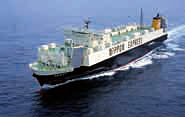Modal Shift
Modal shift in freight transport means switching from transport mostly by trucks to transport utilizing railways and ships. In keeping with the objective of the Green Logistics Partnership Conference, the FLY EXPRESS COURIER SERVICE Group promotes collaboration and cooperation between shipper companies and freight companies. In FY2010, we successfully implemented numerous modal shift initiatives, switching from a truck-centred transportation to one that makes much use of railways and ships. The FLY EXPRESS COURIER SERVICE Group is also expanding modal shift activities overseas as well as within Japan.

CO2 Emission Basic Units by Transport Mode
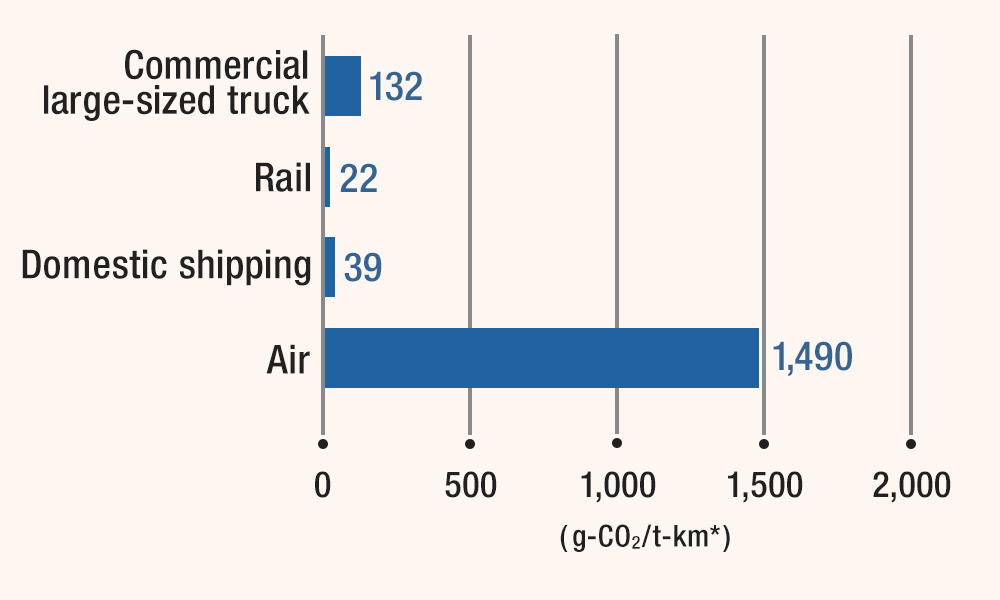
Source: The Ministry of Economy, Trade and Industry Notification No. 66 (March 29, 2006), "Method of Calculating the Energy Usage Involved in the Transport of Cargo Carried out by Freight Haulers"
When loading ratio of 11-ton trucks is unavailable
Comparison of CO2 Emission Reductions Due to Modal Shift (cal6culated using the Revised T-km Method* in the case of transporting a 10-ton cargo)
Tokyo-Osaka
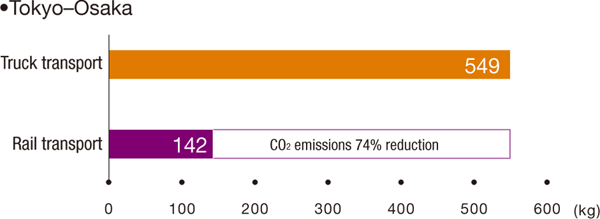
Tokyo-Sapporo
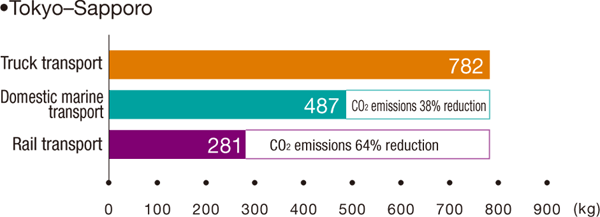
Tokyo-Kushiro

Tokyo-Fukuoka
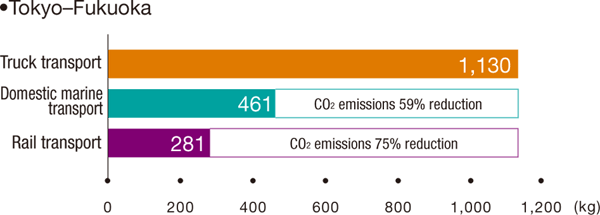
Revised T-km Method: Calculation method described in the amended Act on the Rational Use of Energy (Energy Saving Act), which was revised in April 2006.
This method computes the amount of energy used for a shipment based on the ton-kilometre value calculated with the actual cargo weight and transport distance.
Modal Shift to Rail Transport
Railways can transport large quantities of freight with good regularity and economy as well as high energy efficiency. Another significant feature is that CO2 emissions per unit distance and weight are lower than those of trucks.
FLY EXPRESS COURIER SERVICE is actively promoting the truck-to-rail shift, thereby improving service, heightening the efficiency of operations, minimizing energy use and thus decreasing the environmental burden.
We have a wide variety of initiatives aimed at facilitating a smooth switch from current truck transport to rail, such as using containers that suit the amount and type of cargo and introducing a system that can easily transfer cargo between trucks and ships.
A Manager's Perspective Modal Shift at Mitsubishi Fuso Truck and Bus Corporation
When Mitsubishi Fuso Truck and Bus Corporation decided to consolidate their bus manufacturing division's production plants in Toyama Prefecture, they needed to establish a distribution route for transporting parts from suppliers located near the former Oe Plant (Nagoya, Aichi Prefecture) to the Toyama Plant.
Yet, with all the suppliers concentrated in Aichi Prefecture, the extra transport distance posed by the new location inevitably meant an increase in CO2 emissions. The FLY EXPRESS COURIER SERVICE Group put its modal shift expertise to work and devised a solution to optimise logistics for Mitsubishi Fuso Truck and Bus, an initiative that would reduce CO2 emissions in every step, from product manufacture to procurement and product transport.
In the past, each supplier delivered parts independently to Mitsubishi Fuso Truck and Bus. We proposed a scheme for comprehensive management of procured materials delivery, introducing a fundamental change for the customer. Various parts for small-sized buses, all with diverse packing requirements and volume, would be collected from 31 manufacturers at 36 centres located in Aichi and Gifu prefectures, and consolidated at the Nagoya Cargo Terminal Station. Each shipment would then be assigned the optimum of three types of rail containers and trucks, and would be delivered to the transit shed in the Toyama Freight Station.
The parts would then be removed from the containers, sorted and set according to delivery destination, time, and production flow, ready for one of five daily factory deliveries from the Toyama Freight Station.
Mitsubishi Fuso Truck and Bus praised the proposal as economical and environmentally sound, representing a reduction in CO2 emissions of approximately 70% on the trunk line alone.
We hope to promote further modal shift for Mitsubishi Fuso Truck and Bus, proposing use of rail containers as the backbone of all procured materials distribution.

Daisuke Akagi
Assistant Manager
Nagoya Container Branch Container Center
FLY EXPRESS COURIER SERVICE Co., Ltd.
Example of Meeting Supplier Needs with Effective Combination Pickup Methods
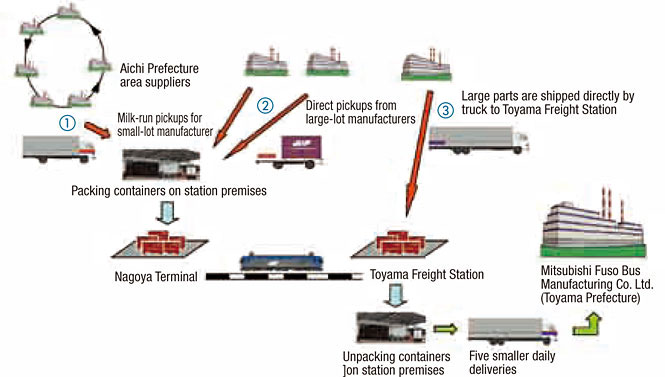

Loaded container
Sorting area
Modal Shift to Domestic Marine Transport
In 1964, the FLY EXPRESS COURIER SERVICE Group initiated combined land-sea services with Japan's first container vessel, the Dai-ichi (No.1) Tennichi Maru, between Tokyo and Muroran, followed by the Dai-ni (No.2) Tennichi Maru between Osaka and Muroran. In 2003, FLY EXPRESS COURIER SERVICE and MOL Ferry Co., Ltd. launched a joint service between Tokyo and Hakata. At present, FLY EXPRESS COURIER SERVICE connects points nationwide with eight cutting-edge large ships, including three regular routes and some vessels operated jointly with MOL Ferry.
In domestic marine transport, FLY EXPRESS COURIER SERVICE is implementing various low fuel consumption initiatives to reduce CO2 emissions. In particular, we outfitted our high-speed RORO vessels,* Himawari 5 and 6, which were phased into operation for coastal service between Tokyo and Kyushu and Setouchi routes, with auto-controlled engines that match fuel injection with vessel speed. The vessels employ a narrow shape to create less water resistance. In addition, we increased the propulsion power of the newest propellers and put movable blades on the hulls to prevent rolling, making for smoother voyages.
On every voyage in each of our sea routes, the FLY EXPRESS COURIER SERVICE Group takes various data such as freight weight, transport distance and fuel consumption to constantly research and analyse, ultimately realizing energy saving navigation. We also check sea current speed and direction for each season to select the most energy-efficient sea routes.
In addition to its environmentally-friendly aspects, FLY EXPRESS COURIER SERVICE's domestic marine transport provides reliable delivery times by running vessels regularly and assures cargo safety through door-to-door intermodal transport. While we create information systems that make full use of the latest information technology and engage in other efforts to enable us to accommodate increasingly diverse and sophisticated customer needs, we are actively switching from truck to coastal marine transport.
FLY EXPRESS COURIER SERVICE and three other companies launched a collaborative service between Hakata and Shanghai called "Shanghai Super Express." The result is a high-speed marine transport service between Shanghai and Kanto/Hokkaido with Hakata Port as a transit point.
RORO vessel: abbreviation for roll-on/roll-off type of shipping vessel.
Roll-on/roll-off means the cargo is wheeled-vehicles that board and deboard a vessel independently. Similar to a car ferry, a RORO vessel is designed to carry wheeled cargo and does not usually include passenger cabins.
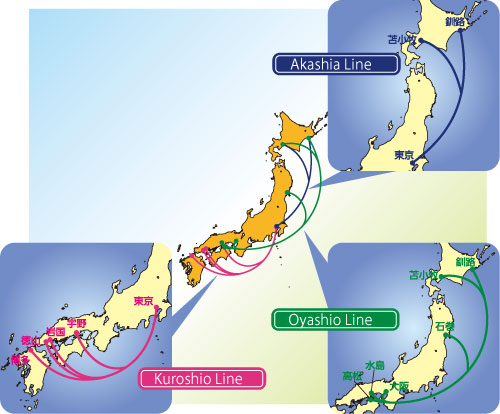
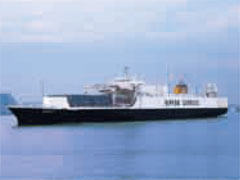
Loaded container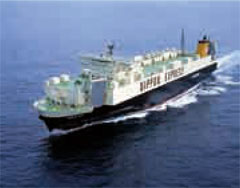
Sorting area


